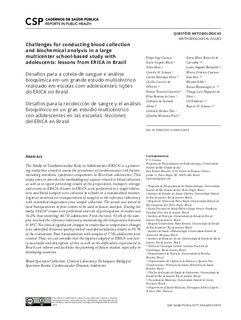| dc.contributor.author | Cureau, Felipe Vogt | |
| dc.contributor.author | Bloch, Katia Vergetti | |
| dc.contributor.author | Henz, Aline | |
| dc.contributor.author | Schaan, Camila W. | |
| dc.contributor.author | Klein, Carlos Henrique | |
| dc.contributor.author | de Oliveira, Cecilia Lacroix | |
| dc.contributor.author | Giannini, Denise Tavares | |
| dc.contributor.author | de Leon, Elisa Brosina | |
| dc.contributor.author | Abreu, Gabriela de Azevedo | |
| dc.contributor.author | Telo, Gabriela Heiden | |
| dc.contributor.author | Dias, Glauber Monteiro | |
| dc.contributor.author | de Carvalho, Kênia Mara Baiocchi | |
| dc.contributor.author | Barufaldi, Laura Augusta | |
| dc.contributor.author | Kuschnir, Maria Cristina Caetano | |
| dc.contributor.author | Szklo, Moyses | |
| dc.contributor.author | Montenegro Jr., Renan | |
| dc.contributor.author | da Sliva, Thiago Luiz Nogueira | |
| dc.contributor.author | Ekelund, Ulf | |
| dc.contributor.author | Schaan, Beatriz D. | |
| dc.date.accessioned | 2018-01-31T09:13:13Z | |
| dc.date.available | 2018-01-31T09:13:13Z | |
| dc.date.issued | 2017-05-18 | |
| dc.identifier.citation | Cadernos de Saúde Pública. 2017, 33, e00122816 | nb_NO |
| dc.identifier.uri | http://hdl.handle.net/11250/2480859 | |
| dc.description.abstract | The Study of Cardiovascular Risk in Adolescents (ERICA) is a pioneering study that aimed to assess the prevalence of cardiovascular risk factors, including metabolic syndrome components in Brazilian adolescents. This study aims to describe the methodological aspects related to blood collection as well as to report pertaining results of the preparation, transport, storage, and exams in ERICA. Exams in ERICA were performed in a single laboratory and blood samples were collected in schools in a standardized manner. Logistics involved air transportation of samples to the reference laboratory with controlled temperature since sample collection. The serum was stored in local biorepositories in four centers to be used in future analyses. During the study, 284,247 exams were performed and rate of participation in exams was 56.2%, thus involving 40,732 adolescents. From the total, 92.6% of the samples reached the reference laboratory maintaining the temperature between 0-10°C. No clinical significant changes in results due to temperature changes were identified. External quality control recorded satisfactory results in 98.7% of the evaluations. Four biorepositories with samples of 7,785 adolescents were created. Thus, we can consider that the logistics adopted in ERICA was fairly successful and description of this as well as the difficulties experienced in Brazil can inform and facilitate the planning of future studies, especially in developing countries. | nb_NO |
| dc.language.iso | eng | nb_NO |
| dc.publisher | Scielo | nb_NO |
| dc.subject | blood specimen collection | nb_NO |
| dc.subject | clinical laboratory techniques | nb_NO |
| dc.subject | biological specimen banks | nb_NO |
| dc.subject | cardiovascular diseases | nb_NO |
| dc.subject | adolescent | nb_NO |
| dc.title | Challenges for conducting blood collection and biochemical analysis in a large multicenter school-based study with adolescents: Lessons from ERICA in Brazil | nb_NO |
| dc.type | Journal article | nb_NO |
| dc.type | Peer reviewed | nb_NO |
| dc.description.version | publishedVersion | nb_NO |
| dc.rights.holder | This article is published in Open Access under the Creative Commons Attribution license, which allows use, distribution, and reproduction in any medium, without restrictions, as long as the original work is correctly cited. | nb_NO |
| dc.source.journal | Cadernos de Saúde Pública | nb_NO |
| dc.identifier.doi | 10.1590/0102-311X00122816 | |
| dc.description.localcode | Seksjon for idrettsmedisinske fag / Department of Sport Medicine | nb_NO |
